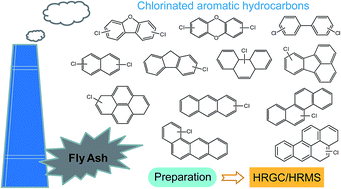Simultaneous determination of chlorinated aromatic hydrocarbons in fly ashes discharged from industrial thermal processes†
Abstract
Chlorinated aromatic hydrocarbons (CAHs) have received increasing attention because of their environmental persistence, bioaccumulation potential and high toxicity. In this study, an analytical methodology based on high-resolution gas chromatography/high-resolution mass spectrometry for the simultaneous determination of four typical kinds of CAHs including polychlorinated dibenzo-p-dioxins and dibenzofurans (PCDD/Fs), polychlorinated biphenyls (PCBs), polychlorinated naphthalenes (PCNs) and chlorinated polycyclic aromatic hydrocarbons (ClPAHs) in fly ash was developed. Highly effective cleanup and separation procedures combined with optimum instrumental conditions provided a reliable method for the detection and quantification of CAHs. Meanwhile, the spike of 13C-labeled standards and deuterated phenanthrene achieved more accurate measurement. The method detection limits were determined to be in the ranges of 0.1–13.4 pg g−1 for tetra- to octa-CDD/F congeners, 0.04–11.1 pg g−1 for tri- to hepta-CB congeners, 0.2–48.5 pg g−1 for mono- to octa-CN congeners and 3.5–9.5 pg g−1 for mono- and di-chlorinated aromatic hydrocarbons. Good recoveries of CAHs (62–136%) were achieved, except for PCN-2 and PCN-6. The developed analytical methodology was validated and then used to determine the levels of CAHs in fly ashes collected from industrial thermal processes. All the target compounds were detected and the CAH congener concentrations showed a wide variation in different fly ashes.



 Please wait while we load your content...
Please wait while we load your content...